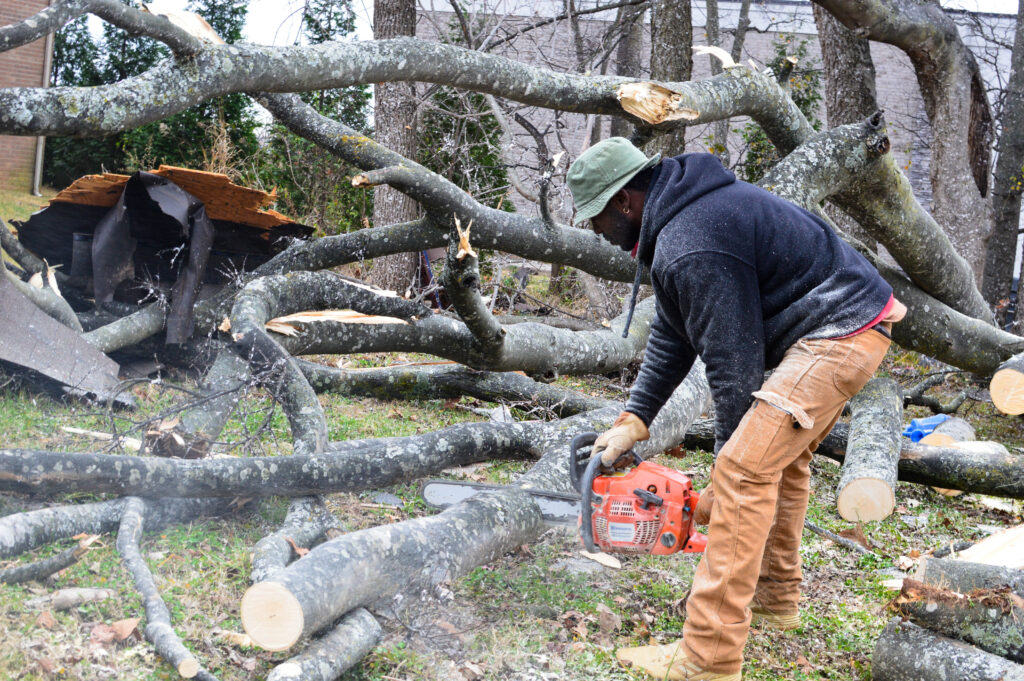
Tornadoes snapped and felled trees across the region this weekend.
In the days following Saturday’s tornadoes, local meteorologists drove across the path of destruction. They discovered uprooted cedar trees in Clarksville, downed pine trees in Dickson County, hundreds of horizontal trees in Hendersonville and “prolific tree damage” south of Ashland City. Near the Old Hickory dam, near Nashville, tornadoes wreaked havoc on “a grove of hundreds of trees in which all of them were either snapped, uprooted, or missing major branches,” the National Weather Service wrote in storm damage summaries.
The agency examines tree damage after storms to help determine whether a tornado or wind harmed an area. With tornadoes, toppled trees can appear chaotic, with crossing trunks, whereas straight-line winds usually cause trees to fall more uniformly.
Tornadoes can wipe out trees
In 2020, a tornado in Nashville decimated thousands of trees, clearing about 422 acres of tree cover in a matter of hours — almost half the city’s total canopy loss recorded between 2008 and 2016. (Windstorms can do a lot of harm, too: Earlier this year, a windstorm took out at least 600 trees in Nashville alone.)
In New York City, in 2010, a tornado was estimated to kill or cripple between thousands to hundreds of thousands of urban trees. This summer, a tornado destroyed an estimated 16,000 mature trees in a Colorado suburb near Denver.
Tornadoes also damage forests.
Tornadoes have a ‘profound’ effect on forest ecosystems
Southeastern states have experienced significant increases in total area and forest area damaged by tornadoes in recent decades, departing from national trends, according to new research from the University of Georgia.
“We wanted to understand how tornadoes — as a mechanism of natural disturbance — affect forests,” said Bronson Bullock, a professor of forest biometrics and a co-author of the study, which is currently undergoing peer review.
While tornado research has historically focused on impacts to human health and infrastructure, the study suggests that tornadoes have a “profound” effect on forest ecosystems.
More: 2023 is Tennessee’s 8th-deadliest year for tornadoes | WPLN News
This is more apparent in the Southeast because the region is more forested than traditional tornado-prone areas. Tennessee is about 53% forested, for example, while Kansas is only 5% and Nebraska is just 3%.
The study is part of ongoing research at the university to examine current methods of assessing tornado damage on forests and adapt forest management techniques to promote resilience.
Saving trees and replanting after tornadoes
Damaged trees can survive after storms. To determine whether a damaged tree poses a safety risk, state officials recommend finding a certified arborist. If the structural integrity of the tree is intact, the tree will likely survive. Even trees leaning about 45 degrees or hardwoods with significant crown loss can survive.
The Tennessee Department of Agriculture recommends pruning, but not topping, damaged trees. The agency also recommends replacing all lost trees and selecting trees that are slower growing to reduce the chances of storm loss. (Hackberries, for example, are a family of fast-growing trees and the most common tree in the greater Nashville area.)
For Davidson County residents, the Nashville Tree Conservation Corps offers free trees after storms and Root Nashville, the campaign to plant 500,000 trees by 2050, prioritizes neighborhoods with storm damage for planting seasons.

